The wonder of moss in our backyard
6 min read / January 22, 2024 / By Liz Thompson
Our website uses cookies to improve your experience. To learn more about how we use cookies, please review our privacy policy.
Can't find what you're looking for? Please contact us.
From the lowest bogs and swamps to the highest mountaintops, these tiny green plants make their living finding moisture and light wherever they can. More than 600 species of bryophytes, the group that includes mosses and liverworts, are known in Vermont.
Mosses need moisture, but unlike flowering plants or ferns, they have no roots and no vascular tissue so they can’t draw water up from the soil. Instead, they get their water from raindrops, fog, dew, or simply from the water they live in. They absorb water directly through their leaves.
With their love for water, mosses and liverworts can be important in absorbing and slowing extra rainwater during storms. They can also be the first green plants to colonize bare wood or soil or even rock, creating a base for larger plants to grow on. A mossy log on the forest floor is often referred to as a “nurse log,” a place for a tree seedling to get its start in life.
Although mosses and liverworts are tiny, they play a big part in the functioning of ecosystems. They are also fascinating and beautiful, especially when we look more closely. So, let’s do that.
(Pictured: Big shaggy moss, or Hylocomiadelphus triquetrus)
Sphagnum moss may be best known as the source of the peat moss that we use in our gardens to add organic matter to the soil. Peat mosses of the genus Sphagnum play an important role in slowing carbon emissions by acting as a carbon sink. They occupy only three percent of the earth’s surface, yet they hold 30% of its carbon.
Sphagnum is easy to find in Vermont—it grows in many bogs and fens that can be visited safely on boardwalks, like the boardwalk in Colchester Bog. The boardwalk itself is home to a variety of mosses and lichens, but under and around the boardwalk is where the Sphagnum grows. It is easily recognized by its puffy, star-shaped heads.
There are more than two dozen species of Sphagnum in Vermont, all occupying specific habitats, even within a bog or fen. Some grow on hummocks, some in hollows, some in acidic soil, some in calcareous soil. Some grow in full sun, others in dense shade.
Fire moss, or purple-stemmed moss, Ceratodon purpureus, grows all over the world, on all continents, in open sunny places in relatively dry and disturbed soil. The name “fire moss” refers to its dominance as an early pioneer in burned areas, particularly in far northern regions. The mosses pictured here were growing in an abandoned gravel parking lot in northern Vermont.
In winter or early spring, as soon as snow cover is gone, the tiny greenish plants sprout thin red stalks with capsules on top, where the spores are produced. In this photo, the capsules are slender and covered with a tan protective hat, but you can also see the old capsules from the previous year, curved over and opened at the top. The thousands of spores have gone off to colonize new territory.
Three-lobed bazzania or greater whipwort, Bazzania trilobata, is abundant in cold boreal woods, growing on the tops of old stumps, on logs, or right on the ground.
Bazzania is not a moss, but a leafy liverwort. Unlike mosses, which have leaves wrapped all around their stems, leafy liverworts have leaves in three rows, two rows on the top and one below. Here, you can see the two rows of leaves on the upper surface of the plant, and each leaf has three small lobes.
This is one of the largest and most conspicuous of the liverworts, and can be found easily in cool moist cedar swamps, spruce-fir-tamarack swamps, and lowland spruce-fir forests.
The contrasting emerald green of brocade moss and deep red of New York scalewort, a leafy liverwort, make for a captivating display on this old cut stump.
Brocade moss, Callicladium imponens, is a very common moss growing on living and dead trees throughout the Northeast. Mosses take two different forms in our region. Some, like brocade moss, lie generally flat and seem two-dimensional, while others, like the fire moss and peat moss, stand up like little trees, and seem three-dimensional.
New York scalewort, Frullania eboracensis, almost always grows on tree trunks or dead wood, and is very common. Its distinctive dark red color makes it easy to spot and recognize, even though it is very tiny.
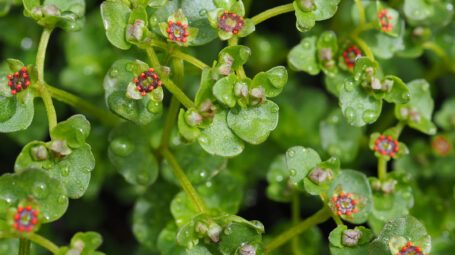
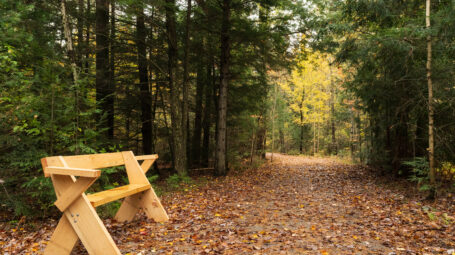
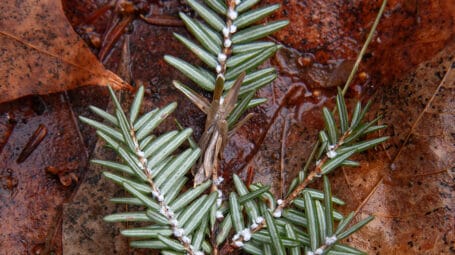
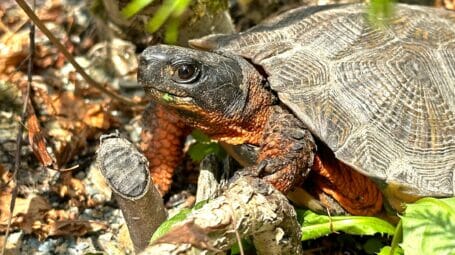
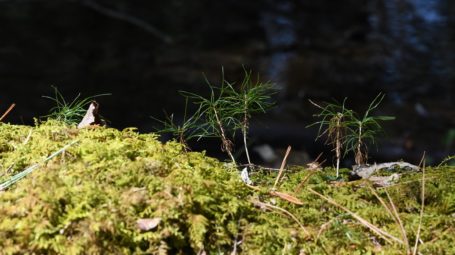
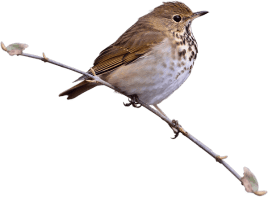
We generally send two emails per month. You can unsubscribe at any time.